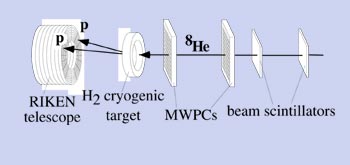The heaviest isotope of hydrogen ever has been detected at the RIKEN laboratory in Japan. The isotope contains six neutrons and one proton and is known as hydrogen-7. An international team of researchers from Japan, Russia, the UK, France and Sweden collided a high-energy beam of helium-8 atoms with a cryogenic hydrogen target to make the novel isotope (A A Korsheninnikov et al. 2003 Phys. Rev. Lett. 082501)

Since the discovery of hydrogen-5 in 2001, physicists have thought that even heavier isotopes – such as hydrogen-7 – could exist, but it was believed that hydrogen-7 would be difficult to detect because it is so unstable. However, advances in experimental techniques, including the use of high-energy beams of short-lived radioactive nuclei, have allowed researchers to look at such unstable systems.
The scientists used radioactive oxygen-18 to produce a high-energy beam of helium-8 atoms at RIKEN. The hydrogen target was supplied by the GANIL laboratory in France. When a helium-8 nucleus reacts with hydrogen, it donates all six of its neutrons to the lighter nucleus and the two protons it leaves behind are then detected by the RIKEN telescope. This device consists of a stack of silicon strip detectors and can measure the energies and angles of several particles at the same time (see figure).
The team also detected tritons – the nuclei of tritium or hydrogen-3 atoms – and neutrons from the break up of hydrogen-7. This method is identical to the one used to produce and detect hydrogen-5. The researchers now hope to improve experimental conditions in their reaction and decrease background effects.



